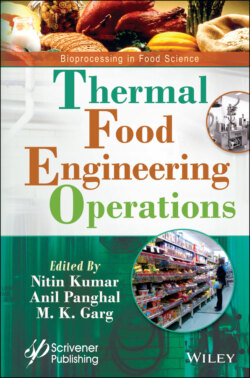Читать книгу Thermal Food Engineering Operations - NITIN KUMAR - Страница 29
1.3.4.2 Advantages and Disadvantages
ОглавлениеAdvantages
1 Particulate foods less than one cubic inch considered appropriate in the resistance heating process; solids content range of 20-70% is deemed to be significant in the liquid-particle mixture flow reaching the plug flow.
2 Mixtures of particles and liquids are evenly heated in some situations because the properties of fluids and the particles are similar such as viscosity, conductance, heat capacity, flow rate, etc.
3 The required temperatures can be achieved rapidly in the case of ultra-high temperature processes as well.
4 There is no hot surface for heat transfer, so the risk from flaming or overprocessing of the product is low.
5 High-energy conversion efficiency.
6 Capital cost relatively low.
7 Colour and nutritional value of food retained.
8 System is environment-friendly.
9 Process control is better than the conventional heating method and more straightforward as well.
10 Reduced fouling compared to that seen in conventional heating.
11 It is an exemplary process for shear-sensitive products since the flow rate is low.
12 Fast and uniform processing of liquid and solid phases which reduces any harm due to heat and retention of nutrients is there [34]. Products treated in ohmic heating have better textural properties than traditional heating procedures.
13 Rapidly heated and heating is volumetric in nature.
14 Easily controllable.
15 Rapid inactivation of microbes and enzymes [46].
16 Storage and distribution in ambient temperature combined with the aseptic filling system.
Disadvantages
1 Installation cost and operation costs are high for ohmic heating systems compared to conventional processing methods.
2 Fat globules present in food are not appropriately heated or heated slowly in ohmic systems because of no conductance (since no salt and water presence) [34].
3 Longer processing time may be required in heating systems to achieve appropriable alterations in food materials, e.g., process of gelatinization of starch.
4 Nutritional and physical attributes of the material bear alterations in the rapid ohmic heating process.
5 Ohmic electrodes may get corroded after the cooking process, and hence final product may also get affected.
6 In continuous ohmic textural softening in beans; changes in the uniformity of product (volume enlargement) were seen, low quality of duct plugging (because of the large size of soybeans) [22, 23].
7 Change in the cell membrane of raw produce due to heat transfer by electro-thermal effect resistance heating, particularly at a low frequency.
8 Loss in Nutritional values and increase in BOD of effluents, e.g., cell-based material coming out from the heating medium is inappropriate for some products or processes
9 Capital funding and safety issues [21–23].
10 Inert electrode material.
11 No proper control in the electrical conductance of all the food constituents because then different heating rates would be there for various components [54].
12 Unavailability of data on essential parameters affects the heating, such as dwell time, direction, level of loading.
13 Inappropriate temperature conformance technology to identify cold/hot locations spot [54].
